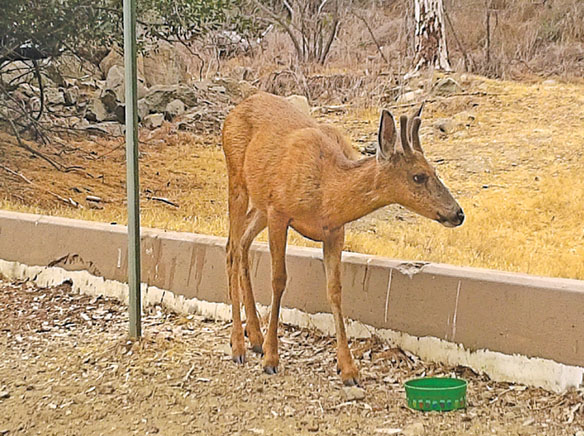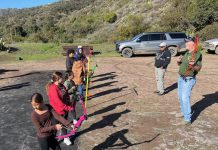Second of two parts.
Following the Conservancy’s Oct. 17 presentation on the restoration plan for the Island, City Council questioned the Conservancy’s representative.
Space wasn’t available in last week’s paper for details about that part of the meeting, so here it is.
The restoration plan has become controversial because part of the plan calls for the Island’s entire mule deer population to be killed by sharpshooters in helicopters.
Mayor Anni Marshall asked why hunters have to have guides.
She asked if she was bold enough to take out a gun and go out there, why not?
“It’s pretty simple,” said Lauren Dennhardt, the Conservancy’s senior conservation director.
“We’re a private land management company,” she said.
“Essentially you all know what the roads are like in the Interior so we just want someone who’s certified to drive on the roads and be able to bring people around,” Dennhardt said.
“It’s mostly a safety issue and a bit of a liability issue as well,” Dennhardt said.
“Is there a problem if a local hunter wants to go out there, who’s got their tags, takes somebody else, not a Conservancy person?” Marshall asked.
Dennhardt didn’t know.
“Can you make it a little more affordable?” asked Councilmember Mary Schickling.
“Because looking at tag prices elsewhere, ours are a lot higher and just to come over here and do it,” Schickling said.
“People have said the Island has kind of priced hunters out of the whole thing,” Schickling said.
According to the California Department of Fish and Wildlife website, the resident first deer tag (or first deer tag drawing application) is $38.62. The second tag: $48.09.
(According to the Catalina Island Conservancy website, resident hunters need to deposit $100 for one Private Land Management tag. For two PLM tags, the cost is $300, of which $200 is a deposit. Deposits are returned if the PLM tag is returned to the Conservancy within five days after a take, and before Dec. 26.)
“Understood,” Dennhardt said.
Dennhardt asked the council to keep in mind the program had been going for 25 years “just trying to maintain this hunting program.”
“We had to spend a lot of extra time and resource,” Dennhardt said.
She said the Conservancy actually loses money on the hunting program.
“It was to help kind of maintain the program and hopefully expand it,” Dennhardt said.
“Part of it we don’t have control over,” she said.
“The state laws are two deer per person,” she said.
She said you have to purchase a CDWF tag. She said she thought there was an extra expense on top of that to just help maintain the hunting program as much as possible.
“But, in reality, the issue is, of course, even if we get 100 extra hunters, it’s still not going to solve the problem,” Dennhardt said.
She said a huge influx of hunters was needed.
“Like I said earlier, we’re a conservation organization. We’re not a hunting outfitter,” Dennhardt said.
“We’re just trying our best to make this functional into the future,” she said.
Asked the cost of the helicopter program, Dennhardt, answering off the top of her head, said she thought it was millions of dollars.
Schickling asked if the millions could be used to bring an influx of hunters to the Island instead.
“Well, we just know that that’s not going to be functional because you would have to maintain it indefinitely,” Dennhardt said.
Councilmember Lisa Lavelle asked what is time sensitive right now.
“Fire risk,” Dennhardt said.
“Every time there’s a fire that occurs on the Island, you lose an entire ecosystem,” she said.
“Are you concerned that having additional vegetation will actually cause more fires and or higher, hotter burning fires?” Lavelle asked.
Dennhardt said the issue was with invasive annual grasslands, you get more frequent fires.
She argued that the fires would come at four to five or 10 years. Dennhardt said you have less frequent fires with the Island’s chaparral. According to Dennhardt, they would be more contained fires.
According to Dennhardt, there would be more time for a response to the burning shrubs versus grassland fires that would burn very quickly.
Lavelle asked about reports or studies that Dennhardt could point her to on some of that information.
According to Dennhardt, said there were a lot of reports from Maui that backed up what she was saying.
Dennhardt said she would send those reports to Lavelle.
Councilmember Yesenia De La Rosa turned to legal options for recycling carcasses. She also said she was doing her best to look at Maui because it seemed the closest to what the Island was going through.
“I found a company called uh Maui Nui Venison and they actually put right on their page right away they’re born out of necessity in the face of an ecological crisis—which is what we’re going through right now,” De La Rosa said.
“I’m in the middle right now,” De La Rosa said.
“I know that we have to choose and of course I’m in no way for the shooting of the deer but I can’t help but try to find a solution because our plants do matter as well,” De La Rosa.
“If you care about the island and you care about the animals, you’re going to care about the plants,” she said.
De La Rosa asked how local Hunters would be able to create a hunting club.
If they could, De La Rosa wanted to know if they could partner with the Conservancy.
She said that the Department of Fish and Wildlife website said there is a commercial hunting club license.
“I don’t know the logistics behind that, but it’s just something that I would like, maybe, if you guys could look into,” De La Rosa said.
“I would like to do this in as respectful way as possible,” Dennhardt said.
She said the Conservancy was really looking for solutions on recycling carcasses.
(As the Islander reported last week, the current plan is for the removal of deer carcasses from areas where they could be seen.)
Dennhardt said she would be happy to entertain any of those options.
“That’s important to people,” she said.
Marshall asked what consideration had been given to the negative consequences to the economy and tourism.
“I’m assuming that’s part of the conversation that went into this when the discussion was addressing how the public would react and what the potential loss of revenue would be across the Island,” Lavelle said.
She said she assumed that the Dennhardt must have at least a ballpark figure.
Dennhardt said the Conservancy was not expecting the deer eradication to affect tourism.
“It’s going to be mostly in the Interior,” Dennhardt said.
“I mean, people in Avalon won’t even know what’s happening,” Dennhardt said.
“And most of our tourists just go to Avalon,” Dennhardt said.
Lavelle said she thought that might be worth looking at.
“I know right now we have very few deer in Avalon,” Marshall said.
She said it was amazing that they don’t pass her house any more. “I mean, they’ve really cleared out quite a bit,” Marshall said.
Dennhardt said some of the deer management would have to happen within Avalon city limits.
“But it’s completely under the jurisdiction of the California Department of Fish and Wildlife,” Dennhardt said.
She said there were a few options available and she was more than happy to discuss that with the city to minimize the impact.
Marshall said the council would need to look into a city ordinance concerning the treatment of animals.
Dennhardt repeated that the deer were completely under the jurisdiction of Fish and Wildlife.
Marshall wanted to know if Fish and Wildlife approves it will happen and if the agency does not approve, it’s not going to happen.
“It’s more than likely going to happen,” Dennhardt said.
“This is something that we’ve been struggling with for a very long time,” she said.
Dennhardt argued that the deer are not adapted to the Island.
“It’s nice to see the deer from a personal standpoint, but it’s a little bit cruel to keep them around for the enjoyment of people when they’re not living a high quality of life here,” she said.
Marshall expressed concern about possible yellowjacket infestation as a result of the deer carcasses.
Marshall asked if the Conservancy could eradicate or minimize the yellowjackets.
(Some yellowjackets are known to eat dead animals, according to the Washington Nature Mapping Foundation.)
Dennhardt said the Conservancy was looking to see if there was mitigation they could do to address that issue.
Responding to a question about where the deer would be hunted, Dennhardt said deer are most active in the early morning and early evening.
“And they’re very good at hiding,” Dennhardt said.
She said the deer would most likely be in an inaccessible locations in the Interior.
Councilmember Schickling asked if the Conservancy’s application to Fish and Wildlife spelled out exactly how the Conservancy would eradicate the deer.
Dennhardt said the Conservancy provided a list of options. She said the permit goes into managing the land and managing the invasive plant species.
“It’s pretty inclusive on the entire restoration strategy,” she said.
Dennhardt confirmed that Fish and Wildlife had yet not signed off on the deer eradication.
Dennhardt did not have a timeline associated with the project.
“So do they put out reports when they’re going through the permit process, like public reports that we could look at?” De La Rosa asked.
“They don’t put up reports but everything is a public document,” Dennhardt said.
Dennhardt said the report that is sometimes referenced is the Conservancy’s Private Lands Management report.
Schickling wanted to know when the deer eradication would begin.
Dennhardt said it would be the second half of 2024.
“I’ve talked to many of you, some of you in the room, or some of the folks here. I have spoken to a lot of you, and we started this early in the process, knowing that this would probably break to the National media using this strategy, but trying to be as respectful to the community as possible by talking to people about this early on,” Dennhardt said.
(The story broke in the Los Angeles Times on Oct. 1. The council meeting was held Oct. 17.)
According to Dennhardt, the eradication would be a multi-year project that would happen around certain times of the year.
Later, Dennhardt said that eradication projects are not popular and lawsuits are generally associated with “every single one of them.”
She said White Buffalo Inc. (the company that would perform the deer eradication) had been dealing with this for 20 years.
The council members asked for the percentage of eradication programs on inhabited Islands. Dennhardt said she would have to check, but she put the figure at about 30 to 40%.
De La Rosa said she wanted the Conservancy, along with the Island Company, to see the support that came out that night.
De La Rosa pointed out that there is a lot of mistrust between the Conservancy, the Island Company, and the community.
“If they could use this as an opportunity to just fix that,” De La Rosa said.
“Because I can see the work you guys are putting in and the genuine effort and I feel so bad that it’s overshadowed by years and years and years of mistrust,” De La Rosa said.
“We’re really interested in being just the best partners and organization we possibly can,” Dennhardt said.
“Beyond this project, please talk to us,” she said.
Dennhardt said she’d had a lot of conversations about the project, of which the first 10 minutes were spent talking about the deer, but other issues came up.
According to Dennhardt, there was something the Conservancy could create that’s special for the community.











